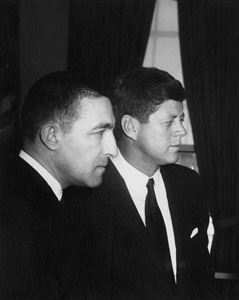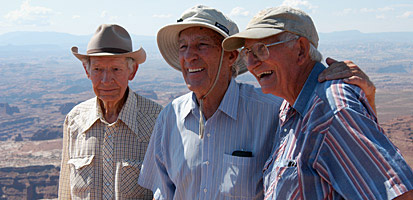The most successful of all secretaries of the interior, Stewart Udall was born in 1920 in St. Johns in remote eastern Arizona. “I feel, looking back over my life, that I actually grew up in the nineteenth century. It was still the frontier.” Coming from a public-spirited farm family, he loved the land and wanted to serve. In 1954 he ran for Congress and won.

When President Kennedy appointed him Secretary of the Interior in 1961 (the first Arizonan to hold a cabinet-level position), the idealistic young secretary took on a rare and daunting task—to write a book while in office. He burned the midnight oil and in two years completed The Quiet Crisis, both a history of conservation and a powerful moral call for Americans to protect the land and waters from the ravages of development and pollution. Coming just a year after Rachel Carson’s Silent Spring, Udall’s book fit beautifully with hers (the two became close friends) in heralding a new age of environmentalism.
Udall served during the height of the Big Buildup, the furious development rampage of the Post-World War II years in which industry and the booming western cities joined together to carry out water and energy development of unprecedented magnitude. An activist secretary heading up a department that had previously been captured the developers, he had to draw upon every last bit of vision, determination, and courage he could muster. Udall reformed key provisions in the badly outdated Hardrock Mining Law of 1872. He played a major role in conceiving and enacting the Wild and Scenic Rivers Act of 1968. Udall proposed and achieved all manner of congressional and presidential land preservation areas, including three national parks, six national monuments, eight national seashores and lakeshores, and 56 national wildlife refuges.
Some of his best work was done in the canyon country of the Southwest. In 1961, Floyd Dominy, the able and messianic commissioner of reclamation who never saw a dam-and-reservoir project he didn’t like, was perhaps the most powerful person in the American West. His favorite project at the time was “Junction Dam,” just below the Confluence, glory country where the Colorado and Green rivers come together. The resulting reservoir—a goliath that would have inundated 93 miles of the Colorado, 109 miles of the Green, and the town of Moab—would have been far and away the largest water project in the Colorado River watershed. Udall and Dominy were at a meeting in Page, Arizona and Dominy, anxious to gain the support of the new secretary, offered Udall a ride back to Washington in his government plane to show him the Junction Dam site. (One of Udall’s reactions was, “So the reclamation commissioner has his own plane but the goddammed secretary doesn’t?!!”)
For once, Dominy was unable to control an interior secretary. When the plane got to the proposed dam site, Udall saw something else. “I saw the Needles and all those monuments and formations and all the rest. I didn’t say anything to Dominy, but to myself I thought, ‘God almighty, that’s a national park!’ ” By 1964, Congress established Canyonlands National Park, the largest in Utah, and the Junction Dam proposal was consigned to the trash heap.
By the mid-1960s, times were changing but Dominy was still riding high and kept another mega-project alive: he wanted to construct two dams in the Grand Canyon. Dominy had powerful support from the cities and industries pushing the Big Buildup. David Brower of the Sierra Club organized a furious campaign against the idea: ridiculing Dominy’s argument that the dams would be good for recreation (the true reason was energy production), Brower asked, “Should we flood the Sistine Chapel so tourists can get closer to the ceiling?” Facing political heat from dam supporters, including some from the Lyndon Johnson White House, Udall took his time making a decision, but privately made up his mind in 1967. He decided to take an “investigatory” float trip down through the Grand Canyon —and told his staff that he wanted the trip to be run by the National Park Service, not Dominy’s office. After seeing the wonders of the Canyon (he’d never floated it before), he put all of his ducks in order and announced that the Johnson Administration was withdrawing its support for the dams. The projects were dead.

After leaving office in 1969, Udall was a model of public service. He spoke out on public issues in three books and numerous op-ed pieces and speeches. One of the best parts of his legacy is his 30-year crusade for justice for the widows of Navajo uranium miners and atomic test fallout “Downwinders.” These were the people and land that he loved, and his dogged litigation and arguments to Congress exposed previously secret documents and the hideously callous indifference of the mining companies and government and military officials to the cancers, death and disfigurement caused by the radioactivity. "Where I come from, if you take on a job, you finish it," Udall said. "Particularly when you look at the tragedy inflicted on these people--I just couldn't let it go."
Udall passed away in 2010. That same year, Congress passed legislation, signed by President Obama, renaming the Main Interior Building in Washington, DC, the “Stewart Lee Udall Department of the Interior Building.” The honor was widely cheered, for Udall had set the interior department on a new course. As one person put it, “If you've ever enjoyed a national park, hiked down a trail, backpacked into wilderness, or paddled a wild and scenic stream, pause and give a minute of thanks for Stewart L. Udall.”
America’s Top 10 Conservation Heroes is a series honoring the individuals and organizations that have made the biggest mark on conservation, environmental protection, and awareness of the outdoors. The series is written by Charles Wilkinson, Distinguished Professor at the University of Colorado and author of fourteen books on law, history, and society in the American West.
Header Photo: Stewart Udall (center) with Senator Edward Muskie (Photo courtesy of the Edmund S. Muskie Archives)
America’s Top 10 Conservation Heroes
1. Theodore Roosevelt
2. John Muir
3. Rachel Carson
4. Stewart Udall
5. Aldo Leopold
6. Ansel Adams
7. Earthjustice
8. Henry David Thoreau
9. Edward Abbey
10. Bruce Babbitt
